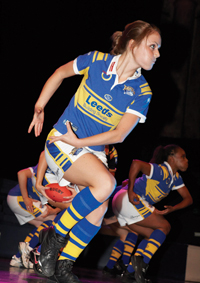A sporting relationship
The relationship between the arts and sport has deep roots and will outlive the temporary spotlight cast on it by the Cultural Olympiad. Doug Sandle explains why

While the Cultural Olympiad has provided many opportunities for the arts, both nationally through the London 2012 festival and regionally through the Legacy Trust UK, many other sporting competitions and festivals world-wide are increasingly associated with arts programmes and provide an impetus for the arts and their development. The Euro 2012 football tournament for example, through a festival provided by the Polish Department of Culture and National Heritage in association with co-hosts Ukraine, had an ambitious arts programme entitled Stadiums of Culture, which commenced in August 2011.
The relationship between the arts and sport in such programmes can appear to be indirect and problematic, with the two being brought together solely within a context of public celebration or to promote a national image. While the arts events and projects of the Cultural Olympiad include several that are more directly linked to sport, or engage the public with a common concern with the Olympic ideals, it might be argued that there is generally a tangential relationship between the arts and sport. However, when choreographer Andy Howitt produced a dance piece inspired by Archie Gemmel’s spectacular goal for Scotland in the 1978 World Cup, or when dancer Marianela Nuñez, in response to a question about which artists she most admired, answered “football players”, there is an acknowledgment that the aesthetic, expressive and narrative qualities of sport can have a more direct and significant relationship with the arts. While the aesthetics of sport is much debated philosophically, in practice arts professionals from across the artform spectrum – music, visual art, drama, film, poetry, dance, performance – are increasingly involved with creative practice that more directly relates to our expressive experience and engagement with many types of sport and their sensory, formal and symbolic characteristics.
Commercial and public interest in the ‘arts of sport’ is also growing. This is evidenced by the popular exhibition on tennis and art, Court on Canvas, held last year at the Barber Institute of Fine Arts in Birmingham; and a successful Cork Street gallery exhibition on football in 2010, ‘England’s Glory’, where more than 200 works by many professional and established artists were exhibited with many sales. Opportunities for arts professionals are also provided by sports organisations, associations and clubs themselves, where the focus is often on creative responses to a particular form and type of sport to celebrate and promote that sport. The Bupa Great North Run for example, has a well-established annual arts programme, Great North Run Culture, whereby writers, film-makers, musicians and contemporary dancers and visual artists have the opportunity to express the excitement, drama and aesthetic qualities of the world’s most popular half-marathon running event.
Artist-in-residence schemes have in recent years been initiated and supported by several sporting clubs and associations (including for example in tennis, football, rugby union and league, and the British Grand Prix). In 2007 the Leeds Rugby Foundation, the educational and community charity of Leeds Rugby, through its Leeds Rugby Arts group and with a grant from Arts Council England, Yorkshire, initiated a year-long artist in residence programme. The residency enabled multi-media artist Jason Minsky to further develop his practice in relation to sport, which led to his subsequent award of the Gymnasium Gallery annual fellowship in Berwick. According to the then Leeds Rugby Foundation Manager, Chris Rostron, the residency “made us look differently and imaginatively at what we were doing”. Leeds Rugby Arts, with sponsorship through the Leeds City Council’s Concert Officer and Leeds Metropolitan University, also commissioned composer Carl Davis to create a seven-minute orchestral tribute, ‘Hold On’, to celebrate Leeds Rhinos’ rugby league successes. Davis also ran classes in musical composition and expression for local school students as part of the commission. Hold On, subsequently recorded by the Orchestra of Opera North, expresses and captures the energy, movements and competitive drama of a rugby league match, and is structured around distinctive phases of the game. A contemporary dance piece, ‘Dancing with Rhinos’, was later choreographed to Hold On by Sharon Watson, now Creative Director for Phoenix Dance Theatre, and performed by community and semi-professional academy dancers. This year a subsequent dance, ‘Score’, on the theme of football, has been developed in association with the Leeds United Foundation. Both dances, under the title of ‘Dancing on Together’, are part of ‘imove’, a regional Cultural Olympiad programme for Yorkshire, and this year’s performances include on-the-pitch match day presentations, bringing a contemporary arts experience to thousands of fans.
In one respect, Martin Creed’s ‘Work No. 850’, in which runners set off at intervals to run through the galleries of Tate Britain, not only symbolised that there can be common ground in our aesthetic engagement with arts and sport, but that innovative opportunities exist for professional practices that bring together arts and sports in creative and mutually supportive ways and which can create new ‘audiences’ for both.
Join the Discussion
You must be logged in to post a comment.